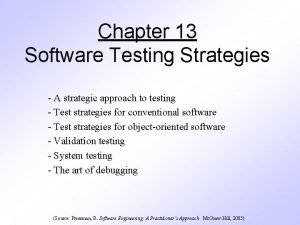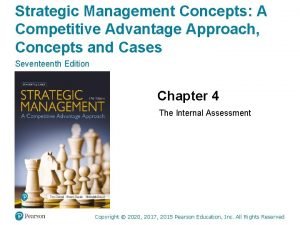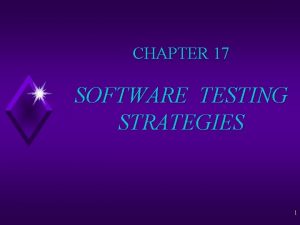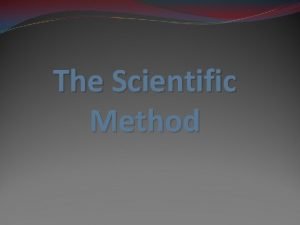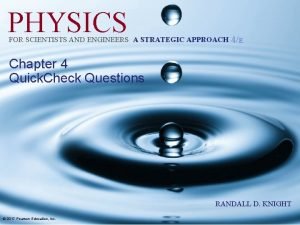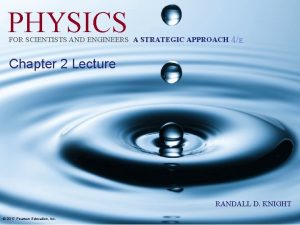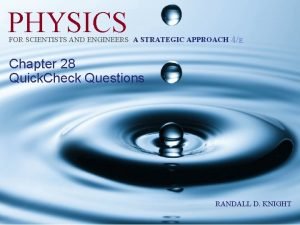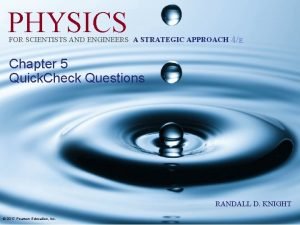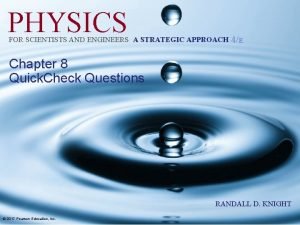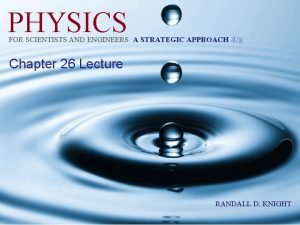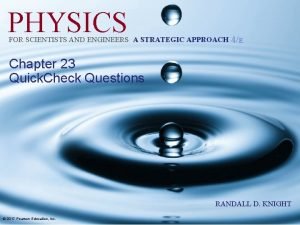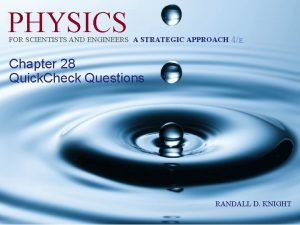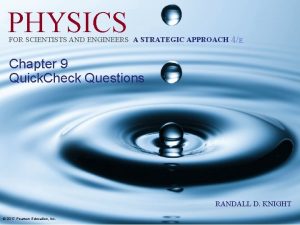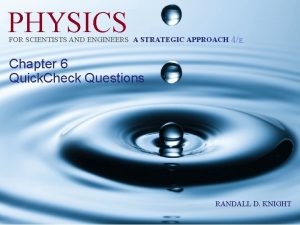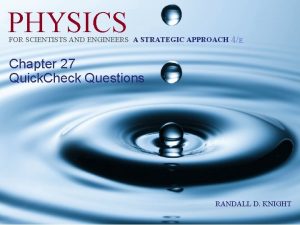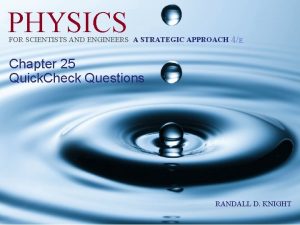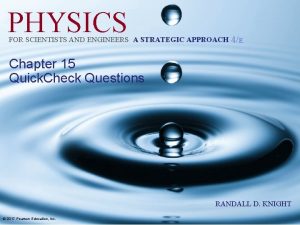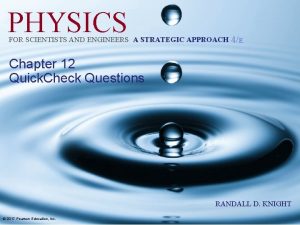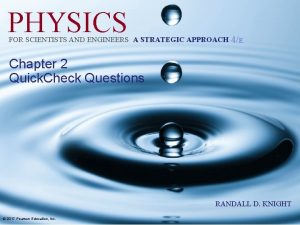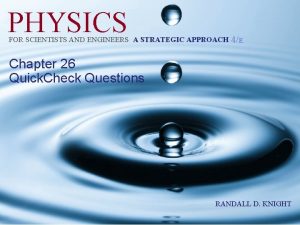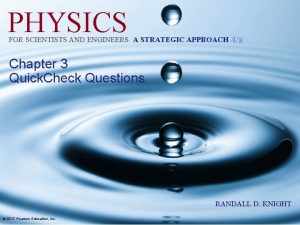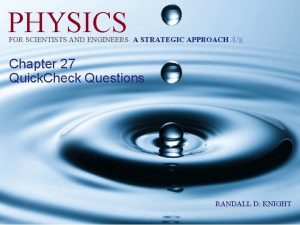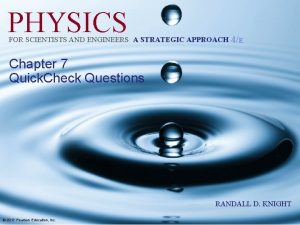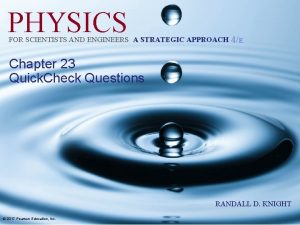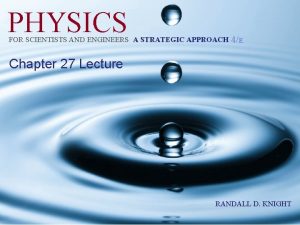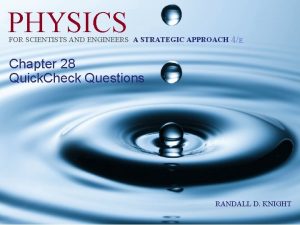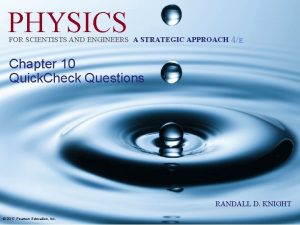PHYSICS FOR SCIENTISTS AND ENGINEERS A STRATEGIC APPROACH































- Slides: 31

PHYSICS FOR SCIENTISTS AND ENGINEERS A STRATEGIC APPROACH 4/E Chapter 24 Quick. Check Questions RANDALL D. KNIGHT

Quick. Check 24. 1 The electric flux through the shaded surface is A. 0 B. 200 N m/C C. 400 N m 2/C D. Flux isn’t defined for an open surface. © 2017 Pearson Education, Inc. Slide 24 -2

Quick. Check 24. 1 The electric flux through the shaded surface is A. 0 B. 200 N m/C C. 400 N m 2/C D. Flux isn’t defined for an open surface. © 2017 Pearson Education, Inc. Slide 24 -3

Quick. Check 24. 2 The electric flux through the shaded surface is A. 0 B. 200 N m/C C. 400 N m 2/C D. Some other value. © 2017 Pearson Education, Inc. Slide 24 -4

Quick. Check 24. 2 The electric flux through the shaded surface is A. 0 B. 200 N m/C C. 400 N m 2/C D. Some other value. © 2017 Pearson Education, Inc. Slide 24 -5

Quick. Check 24. 3 The electric flux through the shaded surface is A. 0 B. 400 cos 20º N m 2/C C. 400 cos 70º N m 2/C D. 400 N m 2/C E. Some other value. © 2017 Pearson Education, Inc. Slide 24 -6

Quick. Check 24. 3 The electric flux through the shaded surface is A. 0 B. 400 cos 20º N m 2/C C. 400 cos 70º N m 2/C D. 400 N m 2/C E. Some other value. © 2017 Pearson Education, Inc. Slide 24 -7

Quick. Check 24. 4 Surfaces A and B have the same shape and the same area. Which has the larger electric flux? A. Surface A has more flux. B. Surface B has more flux. C. The fluxes are equal. D. It’s impossible to say without knowing more about the electric field. © 2017 Pearson Education, Inc. Slide 24 -8

Quick. Check 24. 4 Surfaces A and B have the same shape and the same area. Which has the larger electric flux? A. Surface A has more flux. B. Surface B has more flux. C. The fluxes are equal. D. It’s impossible to say without knowing more about the electric field. © 2017 Pearson Education, Inc. Slide 24 -9

Quick. Check 24. 5 Which surface, A or B, has the larger electric flux? A. Surface A has more flux. B. Surface B has more flux. C. The fluxes are equal. D. It’s impossible to say without knowing more about the electric field. © 2017 Pearson Education, Inc. Slide 24 -10

Quick. Check 24. 5 Which surface, A or B, has the larger electric flux? A. Surface A has more flux. B. Surface B has more flux. C. The fluxes are equal. D. It’s impossible to say without knowing more about the electric field. © 2017 Pearson Education, Inc. Slide 24 -11

Quick. Check 24. 6 These are cross sections of 3 D closed surfaces. The top and bottom surfaces, which are flat, are in front of and behind the screen. The electric field is everywhere parallel to the screen. Which closed surface or surfaces have zero electric flux? A. B. C. D. E. Surface A Surface B Surface C Surfaces B and C All three surfaces © 2017 Pearson Education, Inc. Slide 24 -12

Quick. Check 24. 6 These are cross sections of 3 D closed surfaces. The top and bottom surfaces, which are flat, are in front of and behind the screen. The electric field is everywhere parallel to the screen. Which closed surface or surfaces have zero electric flux? A. B. C. D. E. Surface A Surface B Surface C Surfaces B and C All three surfaces © 2017 Pearson Education, Inc. Slide 24 -13

Quick. Check 24. 7 The electric field is constant over each face of the box. The box contains A. Positive charge. B. Negative charge. C. No net charge. D. Not enough information to tell. © 2017 Pearson Education, Inc. Slide 24 -14

Quick. Check 24. 7 The electric field is constant over each face of the box. The box contains A. Positive charge. Net flux is outward. B. Negative charge. C. No net charge. D. Not enough information to tell. © 2017 Pearson Education, Inc. Slide 24 -15

Quick. Check 24. 8 Which spherical Gaussian surface has the larger electric flux? A. Surface A B. Surface B C. They have the same flux. D. Not enough information to tell. © 2017 Pearson Education, Inc. Slide 24 -16

Quick. Check 24. 8 Which spherical Gaussian surface has the larger electric flux? A. Surface A B. Surface B C. They have the same flux. D. Not enough information to tell. Flux depends only on the enclosed charge, not the radius. © 2017 Pearson Education, Inc. Slide 24 -17

Quick. Check 24. 9 Spherical Gaussian surfaces of equal radius R surround two spheres of equal charge Q. Which Gaussian surface has the larger electric field? A. B. C. D. Surface A Surface B They have the same electric field. Not enough information to tell. © 2017 Pearson Education, Inc. Slide 24 -18

Quick. Check 24. 9 Spherical Gaussian surfaces of equal radius R surround two spheres of equal charge Q. Which Gaussian surface has the larger electric field? A. B. C. D. Surface A Surface B They have the same electric field. Not enough information to tell. © 2017 Pearson Education, Inc. Slide 24 -19

Quick. Check 24. 10 A spherical Gaussian surface surrounds an electric dipole. The net enclosed charge is zero. Which is true? A. The electric field is zero everywhere on the Gaussian surface. B. The electric field is not zero everywhere on the Gaussian surface. C. Whether or not the field is zero on the surface depends on where the dipole is inside the sphere. © 2017 Pearson Education, Inc. Slide 24 -20

Quick. Check 24. 10 A spherical Gaussian surface surrounds an electric dipole. The net enclosed charge is zero. Which is true? A. The electric field is zero everywhere on the Gaussian surface. B. The electric field is not zero everywhere on the Gaussian surface. C. Whether or not the field is zero on the surface depends on where the dipole is inside the sphere. The flux is zero, but that doesn’t require the field to be zero. © 2017 Pearson Education, Inc. Slide 24 -21

Quick. Check 24. 11 The electric flux is shown through two Gaussian surfaces. In terms of q, what are charges q 1 and q 2? A. q 1 = 2 q; q 2 = q B. q 1 = q; q 2 = 2 q C. q 1 = 2 q; q 2 = –q D. q 1 = 2 q; q 2 = – 2 q E. q 1 = q/2; q 2 = q/2 © 2017 Pearson Education, Inc. Slide 24 -22

Quick. Check 24. 11 The electric flux is shown through two Gaussian surfaces. In terms of q, what are charges q 1 and q 2? A. q 1 = 2 q; q 2 = q B. q 1 = q; q 2 = 2 q C. q 1 = 2 q; q 2 = –q D. q 1 = 2 q; q 2 = – 2 q E. q 1 = q/2; q 2 = q/2 © 2017 Pearson Education, Inc. Slide 24 -23

Quick. Check 24. 12 A cylindrical Gaussian surface surrounds an infinite line of charge. The flux Φe through the two flat ends of the cylinder is A. 0 B. 2× 2πr. E C. 2×πr 2 E D. 2×r. LE E. It will require an integration to find out. © 2017 Pearson Education, Inc. Slide 24 -24

Quick. Check 24. 12 A cylindrical Gaussian surface surrounds an infinite line of charge. The flux Φe through the two flat ends of the cylinder is A. 0 B. 2× 2πr. E C. 2×πr 2 E D. 2×r. LE E. It will require an integration to find out. © 2017 Pearson Education, Inc. Slide 24 -25

Quick. Check 24. 13 A cylindrical Gaussian surface surrounds an infinite line of charge. The flux Φe through the wall of the cylinder is A. 0 B. 2πr. LE C. πr 2 LE D. r. LE E. It will require an integration to find out. © 2017 Pearson Education, Inc. Slide 24 -26

Quick. Check 24. 13 A cylindrical Gaussian surface surrounds an infinite line of charge. The flux Φe through the wall of the cylinder is A. 0 B. 2πr. LE C. πr 2 LE D. r. LE E. It will require an integration to find out. © 2017 Pearson Education, Inc. Slide 24 -27

Quick. Check 24. 14 A point charge q is located distance r from the center of a neutral metal sphere. The electric field at the center of the sphere is A. B. C. D. 0 E. It depends on what the metal is. © 2017 Pearson Education, Inc. Slide 24 -28

Quick. Check 24. 14 A point charge q is located distance r from the center of a neutral metal sphere. The electric field at the center of the sphere is A. B. C. D. 0 E. It depends on what the metal is. © 2017 Pearson Education, Inc. Slide 24 -29

Quick. Check 24. 15 Charge +3 n. C is in a hollow cavity inside a large chunk of metal that is electrically neutral. The total charge on the exterior surface of the metal is A. 0 n. C B. +3 n. C C. – 3 n. C D. Can’t say without knowing the shape and location of the hollow cavity. © 2017 Pearson Education, Inc. Slide 24 -30

Quick. Check 24. 15 Charge +3 n. C is in a hollow cavity inside a large chunk of metal that is electrically neutral. The total charge on the exterior surface of the metal is A. 0 n. C B. +3 n. C C. – 3 n. C D. Can’t say without knowing the shape and location of the hollow cavity. © 2017 Pearson Education, Inc. Slide 24 -31
 Strategic substitutes and complements
Strategic substitutes and complements Strategic management and strategic competitiveness
Strategic management and strategic competitiveness Strategic analysis and choice in strategic management
Strategic analysis and choice in strategic management Datagram network and virtual circuit network
Datagram network and virtual circuit network Deep learning approach and surface learning approach
Deep learning approach and surface learning approach Strategic fit vs strategic intent
Strategic fit vs strategic intent Incremental approach in strategic management
Incremental approach in strategic management Role of corporate governance in strategy formulation
Role of corporate governance in strategy formulation Strategic choice approach
Strategic choice approach A strategic approach to software testing
A strategic approach to software testing Strategic management a competitive advantage approach
Strategic management a competitive advantage approach A strategic approach to software testing
A strategic approach to software testing Commander approach in strategic management
Commander approach in strategic management After the experiment scientists organize and the data
After the experiment scientists organize and the data Diagrams tables and graphs are used by scientists mainly to
Diagrams tables and graphs are used by scientists mainly to Why does it happen
Why does it happen University physics with modern physics fifteenth edition
University physics with modern physics fifteenth edition Physics ia ideas
Physics ia ideas Kontinuitetshantering i praktiken
Kontinuitetshantering i praktiken Typiska novell drag
Typiska novell drag Nationell inriktning för artificiell intelligens
Nationell inriktning för artificiell intelligens Ekologiskt fotavtryck
Ekologiskt fotavtryck Shingelfrisyren
Shingelfrisyren En lathund för arbete med kontinuitetshantering
En lathund för arbete med kontinuitetshantering Personalliggare bygg undantag
Personalliggare bygg undantag Personlig tidbok fylla i
Personlig tidbok fylla i Anatomi organ reproduksi
Anatomi organ reproduksi Densitet vatten
Densitet vatten Datorkunskap för nybörjare
Datorkunskap för nybörjare Stig kerman
Stig kerman Att skriva debattartikel
Att skriva debattartikel Autokratiskt ledarskap
Autokratiskt ledarskap









